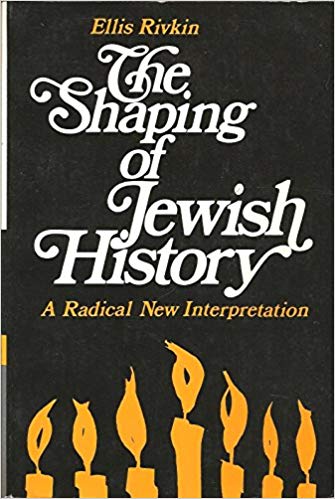File:1971 * Rivkin.jpg
1971_*_Rivkin.jpg (335 × 499 pixels, file size: 36 KB, MIME type: image/jpeg)
The Shaping of Jewish History: A Radical New Interpretation (1971) is a book by Ellis Rivkin.
Abstract
With the modest goal of redesigning all of Jewish, and therefore world, history, Rivkin views all of the complexity of Jewish history as a reworking and elaboration of what he calls the unity concept (or unity principle), a constant feature throughout all of Jewish history, namely the belief in the one omnipotent God. Through the elaboration of this simple concept, the Jews were able to consistently adapt their fundamental belief structure to ever-changing circumstances. Beyond the unity concept, Rivkin’s next major theme running throughout Jewish history is that of power and authority (whether political, social, or economic). The struggle for authority is a dominant theme in the changing landscape of the second temple period, seen in two grand revolutions, the Aaronide and the Pharisaic. The creation and promulgation of the Pentateuch by a new priestly elite created an innovative form of Judaism (or Yahwism) where all authority was effectively transferred from the former monarchic, Levitical, and prophetic parties to this new Aaronide elite, who would dominate Jewish life for hundreds of years. Only with the threat of extreme Hellenism and the transformation of Jerusalem into a Greek polis would another revolution need to occur in order to adapt. This was the creation of a new intellectual elite, the Pharisees. Just as the Aaronides before them had transformed the Pentateuch in order to bolster their own authority, these scribal intellectuals developed the idea of the twofold Law, Written and Oral, in order to assure their own authority over the spiritual lives of the Jewish people. Focus was no longer on priestly mediation and expiation but on the individual’s inward path to salvation. By adhering to the Pharisaic interpretations of the Law, the individual could guarantee immortality and bodily resurrection. This grand revolution was a necessary step in rallying the people to fight off the armies of Antiochus IV. It is directly within the purview of Pharisaic resurrection where Rivkin views the origins of (Paul’s) Christianity. Resurrection was a Pharisaic tenet meant only for those who followed the twofold Law. With Paul’s newfound belief in the resurrection of Christ, someone who rebelled against the Pharisaic notions of Oral Law, the Pharisee Paul came to have a radically transfigured notion of salvation and the Law’s place therein. Influence should not be sought anywhere else, whether in mystery religions, Hellenism, or Greek philosophy. The origin of Pauline Christianity was a direct outcrop of the Pharisaic Revolution. – Jason Zurawski, University of Michigan
Editions and translations
Published in New York: Charles Scribner’s Sons, 1971. Newly revised and expanded edition published in Springfield, NJ: Behrman House, 2003 as:
Table of contents
- 1. Patriarchs and Prophets: One God or Many
- 2. The Revolution of the Aaronides: The Creation of the Pentateuch
- 3. The Pharisaic Revolution: A Decisive Mutation
- 4. Heirs of the ==
Pharisees: The Paths of the Twofold Law
- 5. Medieval Ways to Salvation: Diversity in Unity
- 6. The Rise of Capitalism: The Marranos
- 7. The Grand Universals: The Emancipation of the Jews
- 8. The Triumph of Nationalism: The Entrapment of Capitalism within the Nation-State
- 9. The Road to Auschwitz: The Disintegration of Nation-State Capitalism
- 10. The Road from Auschwitz: The Emergence of Global Capitalism
External links
File history
Click on a date/time to view the file as it appeared at that time.
| Date/Time | Thumbnail | Dimensions | User | Comment | |
|---|---|---|---|---|---|
| current | 15:02, 24 October 2019 |  | 335 × 499 (36 KB) | Gabriele Boccaccini (talk | contribs) |
You cannot overwrite this file.
File usage
There are no pages that use this file.
